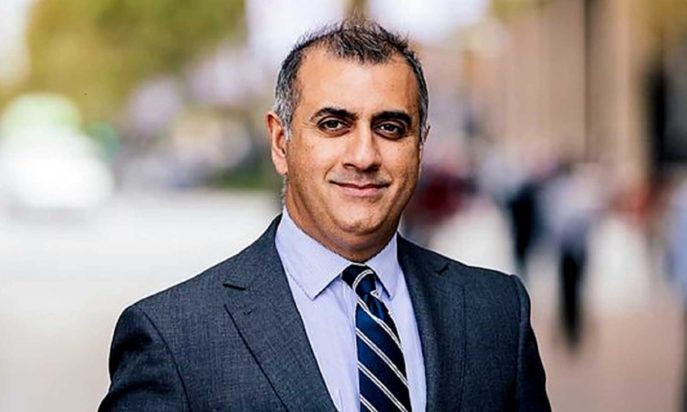Getting in sync with the mega-trends
One of the more unique offerings in the active global equity sector is the Insync Global Quality Equity Fund, run by the fund manager of the same name. Established in October 2009 as the Insync Global Titans Fund – its name was changed in July 2018 – the fund is a high-conviction, active manager that wants to hold 20 to 30 stocks very high-quality companies that are benefiting from disruption, that have long runways of growth through exposure to global “megatrends,” and are highly profitable.
Portfolio managers Monik Kotecha and John Lobb, and senior analyst Mark Haet, met at BT Investment Management in the early 1990s. Kotecha’s resume includes stints at the Abu Dhabi Investment Authority (ADIA), one of the largest Sovereign wealth funds in the world, BT Investment Management and Investors Mutual (IML), before setting-up Insync in 2009; Lobb joined in 2017 after working at Bankers Trust Australia, Citigroup Global Asset Management, Credit Suisse Global Asset Management and Orion Asset Management. Haet has run international equities portfolios at BT Funds Management, Ellerston Capital, QBE Insurance and New York-based hedge fund Kingdon Capital.
Chief executive officer is Garry Wyatt, who is responsible for managing the operational aspects of the business as well as being a key investment team member. Wyatt has held senior financial positions with several major companies including WMC Resources Limited, Tooheys (Victoria) and United Distillers Group.
Insync has two funds in the market, the Insync Global Quality Equity Fund and the Insync Global Capital Aware Fund.
Both funds opened for business in October 2009, but the Global Quality Equity Fund was originally called the Insync Global Titans Fund – the name was changed in July 2018. So, in its performance tables, Insync gives the performance for the Insync Global Capital Aware Fund, and the Insync Global Quality Equity Portfolio, to reflect the fact that it has been managing the Global Quality Equity Fund’s portfolio since October 2009.
The Global Quality Equity Fund seeks to outperform the market, over rolling five-year periods, through choosing a portfolio of high-quality companies that are benefiting from long runways of growth through global megatrends.
The Global Capital Aware Fund is effectively the same portfolio, but uses put options to protect investors against the most severe market falls – the options provide a buffer against the depth and duration of major market falls.​
Here’s the tale of the tape in terms of performance:
Insync’s approach is based around identifying and capturing “megatrends” that Insync expects to play-out over the course of the next decade – broad and deeply entrenched global shifts based on changing consumer behaviour and demographic changes.
Insync’s fund is trying to capture 16 megatrends that it has identified: some technological, such as workplace automation, digitisation and cloud computing; some demographic, such as the economic boom in Africa, which Insync says has a massive demographic tailwind, with the world’s fastest-growing population of young people moving into working age.
The Inside Network recently sat down with Monik Kotecha.
Monik, what is Insync’s investment style? It doesn’t seem to fit neatly into any description.
We’ve had a lot of analytics done on our fund performance and unit holdings, and two things came through one, was that the way we deliver performance does not correlate with a specific style, geographic or sector focus. We feel that researchers love pigeon-holing managers – then, you’re in a bucket. But, they don’t actually get very granular.
As far as style goes, I often think, how did I get here? I’ve been involved in managing money for 30 years, I’ve worked at quite a few different, good firms. I read a lot, I’m a voracious reader. I read across history, politics, psychology, economics. The world is a very complex system, and it’s not a case of backward-looking, looking at data, statistical data and having some ratio and saying, ‘OK, I’m buying all stocks with a P/E below 12, and that’s my style.’
Or I’m a growth manager, so I’m buying something on a PEG ratio. We don’t do any of that. We don’t even think about it. We don’t even look at PEs at Insync, it’s not part of our vernacular. The P/E is not a valuation tool, it’s just a number. The way this process has come together is through all of that thinking, looking at research. I’m very research-driven, empirically-driven, and I’m looking for nuances in the data that no one else is picking up. What is it that really can deliver sustainable, great performance for our clients, with less risk?
You seem to build the portfolio around exposure to investment “megatrends.” What are these?
We look for changes in technology, demographics and consumer preferences, and ask, ‘what are the companies best-positioned to capitalise on these changes?’ We’ve always been global stock-pickers, looking for the best opportunities we can find. But in about 2015, 2016, we noticed something starting to change. We had a bunch of stocks in our portfolio, that weren’t performing very well. And these were stocks that had done really, really well for us in our long-term history. We thought, ‘there’s something going on here.’ We kept digging into the data. And what we found was that a lot of our metrics were still appropriate, but we had to enhance them.
I’ve got a pitch deck from five or so years ago, covering eight sectors from banks to utilities, to consumer staples, to luxury goods. We had the Nestles, the Coca Colas, the Procter and Gambles of this world, the Colgates. For good reasons: Colgate dominates the toothpaste market; Gillette dominates razors. But we started to really notice disruption as a concept.
Whenever you’re looking at an investment, disruption’s always part of your thinking, part of your assessment of management, it’s a threat on the company’s SWOT analysis. And looking at the data, that all these businesses were starting to slow down. A lot of managers were saying, ‘These are great businesses, that have been around for 50 years, this is just a temporary slowdown.’ Well, no – and we were noticing this in sector, after sector, after sector. It was disruption, as more and more companies were getting disintermediated.
We all know that the internet was a bubble in 2000, but by 2015, it had matured and the business model started to evolve. Selling online had become a reality.
Take Procter and Gamble (NYSE: PG), the largest consumer goods company in the world, it has global manufacturing, it’s in virtually every country around the world, people on the ground, it’s in every supermarket around the world, 75% market share in the US and similar globally. It owns Gillette – a fantastic business, great product, it dominates shaving. But between 2012 and 2017, Gillette lost 20% market share.
What was happening was that upstarts like Dollar Shave Club and Harry’s Shave Club disintermediated Gillette. They sold through the internet, they put their videos on You Tube. And as we dug into this, we realised that this was demographics, enabled by the internet. It was the rise of the millennial and Gen Z shoppers.
We’ve realised that when we were growing up, our consumption was generated through radio and TV. And there was probably a couple of channels on both. The big brands would be promoting through those channels, and we’d get exposure to those brands and build up our trust in brands. When we went to Woolworths or Coles or IGA, those brands would dominate the shelf space. So life was very easy for them.
Well that all started to change, from about 2015 on. That was not how Gen Z shops, and not how Gen Z builds trust in brands. And what annoys me most about this is that I could have seen this in my own home – when I started looking into Dollar Shave Club and the impact it was having on Gillette, I discovered that my own teenage son had been a subscriber for three years. I don’t think he would even know how and where else to buy shaving products.
By the end of this decade, Gen Z will be the largest cohort of shoppers in the world. The ramifications of this really blew us away, and we sat down and went through our entire portfolio. We had already been looking at demographic shifts, and we were probably focusing on the ageing population, which is accelerating; but Gen Z was another demographic shift occurring that is having a profound impact on the demand for products and services. And the more you look at young people, the more you realise that Africa has a huge demographic tailwind.
So there’s all these demographic shifts, and they all have their unique characteristics and consumptions and belief systems. Each of those cohorts are very different and they’re very big. And that’s colliding with technology. The internet has continued to accelerate; chips have increased the speed, the performance and the quantum with which things can happen; you’ve got 5G, you’ve got cloud computing, you’ve got artificial intelligence, you’ve got virtual and augmented reality. All of these are going to have profound implications.
What are the megatrends?
The megatrends are very strong long-term forces that are able to impact the economy, society and our lives. They’re seismic global shifts in demand which are powerful in magnitude and enduring in duration. They result from a convergence of different underlying trends including technology, innovation, demographics, social attitudes, lifestyles and consumer behaviour.
We think a megatrend must be disruptive; it must show a significant potential global impact that can upset the status quo in an industry, and the potential to transform, destroy or create new markets. It must be persistent, which it means it must be proven to endure challenges to its survival. And it must be long-term, which means we’re confident that it will last at least ten years.
At the moment, we are focusing on 16 megatrends, that we expect to play out over the next decade, at least:
- Medical services
- Africa
- Catch-up consumption
- Travel/experiences
- The “silver economy” – the ageing of the world population
- Cashless society
- Data analytics
- The streaming explosion
- Industrial connectivity
- Cloud computing
- High-speed broadband
- Digitisation
- workplace automation.
- The Metaverse – where the digital world (augmented reality and virtual reality) converge with our physical lives
- Premiumisation: driven by people’s constant desire for more quality, style, and status as wealth increases
- Pet humanisation
How does your stock-picking tap into these megatrends?
We are very much bottom-up stock-pickers, and we focus on ‘quality.’ We’re looking for very profitable, high-quality companies, and the cornerstone of our valuation process is assessing the drivers of return on invested capital (ROIC). First of all, we’re trying to identify and value those businesses we think are capable of generating the highest future ROIC, and then, were looking for a relationship with a global megatrend – we need to see at least one megatrend supporting the stock. That means, we need to see how this megatrend can help to power the company’s long-term success.
We’re looking for high gross margins, and earnings growth. We call companies that are able to sustainably grow their earnings, and their ROIC, “compounders.” Investing in a portfolio of compounders is one of the best ways to generate wealth with less risk for longer-term oriented investors. Over time they usually beat market averages. We believe the result is a portfolio which delivers strong earnings growth that is also relatively insensitive to economic and inflation cycles.
We favour companies that not only are some of the most profitable companies in the world but are also expected to consistently grow their earnings at high rates regardless of how the global economy performs.
At the moment, our Global Quality Equity Portfolio holds 29 international stocks, with an overweight position in US markets – we’re not looking to be overweight US per se, it’s just the US market is where most of these leaders are. All of these stocks are not only highly profitable and have a long runway of growth, but also generate high gross margins and have the kind of pricing power that enables them to offset growing inflationary pressures, without losing business.
We don’t ever want to have more than 30 stocks in the portfolio, because that starts to become too diversified. But with the right position size, if we hold these stocks for long enough, we think they will compound with a high degree of certainty. Of course, our stocks are not early-stage companies, but what the market misunderstands in them is just the sustainability of growth. The market is not valuing these companies appropriately because it’s not measuring that aspect, and that that’s one of the key arbitrage opportunities we’re taking advantage of.
What are a couple of examples of stocks in the portfolio?
Look at Microsoft (NASDAQ: MSFT) and LVMH (EPA: MC), or Louis Vuitton Moët Hennessy to give it its full name. Obviously, they are in very different industries, but they have common traits that reward our investors. They both possess real pricing power because they both enjoy strong demand for their highly sought-after products. This makes them more defensive in a sustainable inflationary global environment, should that prediction of inflation pan out. These companies are less affected by rising costs and can increase their prices to outpace inflation quite easily. Indeed, both have done, and we have just witnessed this again with Microsoft.
Or, let’s look at profitable winners in the Travel megatrend, in the post-COVID world. Sometimes the winning companies are the less obvious ones. Estee Lauder (NYSE: EL) and Walt Disney (NYSE: DIS) represent two examples of highly profitable businesses in the Insync portfolio that are beneficiaries of the recovery and long-term resumption of secular growth in experiences and travel – travel retail represents 25% of Estee Lauder’s sales.
Zoetis (NYSE: ZTS) is a US$ 5 billion-plus revenue firm that is highly profitable and a global supplier of animal pharmaceuticals. We’ve owned this stock for many years, and it has typically outperformed the benchmark by around 13% over that time. Zoetis taps into ‘pet humanisation,’ which is a global megatrend that has actually accelerated due to the effects of COVID-19, and is unlikely to reverse in coming years. This interesting megatrend is easily evidenced in how much money we are prepared to spend on our pets’ health, what we feed them, and what priority they hold in our overall household decision-making. ‘Pet humanisation’ is not new, and as such it is not a fad – and interestingly, it is a megatrend that doesn’t rely on technology.











